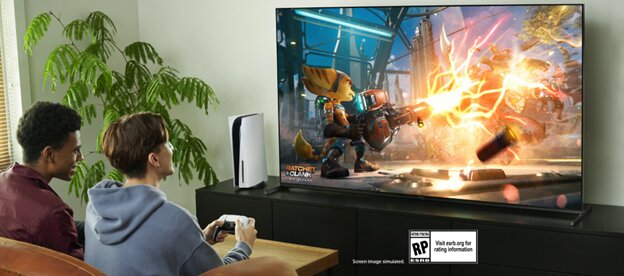Gaming in 8K resolution has evolved from a pipe dream to reality during the past few years. When Nvidia released their Nvidia GeForce RTX 3090 in September 2020, they opened up a massive number of doors. It’s a beast of a card that can handle gaming in 8K using their Deep Learning Super Sampling (DLSS) technology.

8K and its beauty is insanely difficult to render. It’s 16 times bigger than standard HD resolution. More detail, more colors, smoother edges. With DLSS, games can keep a playable frame rate.
Beauty, however, comes at a cost. A gaming rig and monitor for 8K cost a fortune. So the question arises: Is 8K gaming worth it? Even with DLSS making the resolution easier to access, your machine is working hard to render pixels with diminishing returns. Is the extra field of vision (FoV) worth thousands of dollars?
Let’s find out.
The case for 8K
We should settle something first—8K is a possible resolution to see. For those interested in eye math, Dan Sasaki, senior VP of optical engineering and lens strategy at Panavision, explains the human eye’s acuity here. More pixels are always better, as our brains are incredible at perceiving visuals. And this tech is perfect for experiences like VR or other curved screens.
A standard HD resolution is 1920p × 1080p. 8K resolution is 7680p × 4320p, which is 16 times the number of pixels. This is going to strain your machine. Playing native is close to impossible for any game with more detail than Dark Souls II. A higher resolution costs you frames, making the game choppier.
Not anymore. DLSS changed the landscape of which resolutions are playable. In Nvidia’s promo video, playing Metro Exodus: Enhanced Edition went from 39 fps to 105 fps with DLSS enabled. Their advanced AI rendering upscales a game’s frames. It can render a game’s 1080p frames, upscale it, and output it at 4K. DLSS doesn’t work on everything, though; it needs an RTX card, compatible game, monitor, and a machine to withstand it.
Look at that definition in the image above. Minor details in the background come to life, and gamers will notice the small details developers actually put into their games.
This is only on a flat screen. These advantages are doubled for 8K in VR, 360 videos, and other immersive experiences. Palmer Luckey, founder of Oculus VR and inventor of the Rift, speculated that VR users would stop seeing individual pixels at approximately an 8K resolution per eye. Our eyes and their acuity are measured in angles. The curvature of a headset allows us to make better use of our peripheries and the extra pixels 8K offers us.
As technology evolves and we see more breakthroughs, 8K will only get better. DLSS and Nvidia’s AI pushes what’s possible for gamers at home. The AI fills in the gaps created by upscaling, and owners of the RTX 3090s can have their cake and eat it too. More resolution doesn’t have to cost all your frames.
The costs of 8K
The other camp thinks that, at best, 8K is a novelty. That the current technology isn’t worth the amount of effort a consumer has to put in to feel the practical effects. Take a look at Linus Tech Tips’ YouTube video, where host Linus Sebastian is the first person outside of Nvidia to actually play an 8K game. To use 8K effectively, you need a bigger screen that can handle the resolution.
This midrange-option LG NanoCell 99 Series 75-inch 8K smart TV costs about $2,400. The RTX 3080 required to run 8K is no joke, either, in terms of its price. The cheapest prebuilt PC that could run 8K at 60 fps costs about $4,000. Many games support 8K, so we’ll pick the free Apex Legends and peripherals you can nab for cheap. Buying and playing this 8K rig: $6,400 before taxes. This is out of reach for the average consumer. Yes, in coming years, prices will drop as the tech becomes more widely available. As the future unfolds, 8K will become more realistic for most of us.
Even downsizing from a movie TV to a VR set is still expensive. A full 8K setup from Pimax costs about $1,000—much cheaper than the monitor. Businesses that are more focused on providing an 8K VR experience might find more success.
8K offers a unique advantage to VR that a big screen doesn’t use as efficiently: a bigger field of vision. 8K can extend the FoV degrees wider—making a more immersive experience. More pixels equals more immersion. This is a big win for a small industry. While the VR industry has been growing, only 8% of US broadband households own a VR headset, as opposed to the 62% that play games.
Many critics claim that moving from 4K to 8K is negligible. In the normal circumstances of a screen and a couch, it is a matter of taste. Special accommodations must be made for 8K setups, but the extra resolution can make a world of a difference.
Nevertheless, the average gamer is not the main demographic for 8K. As with most emerging tech, it is a playground for people with the means to do so or a business idea.
Is 8K gaming worth it?
For most people, 8K gaming will be a novelty in upcoming years. A friend might have a VR headset and they can use it once in a while. Maybe somebody has a big screen at home. Yet for the typical consumer, 8K is not worth bringing home for thousands of dollars.
For the lucky few who have more to spend, 8K gaming will be a gorgeous experience. More resolution means more pixels for edges to soften out naturally. Games will be more immersive. Every view will have depth. We won’t be able to dissect individual pixels in VR. Developers and video creators can use our peripheral vision against us in every genre, from slasher horror to explosion action titles.
 8K requires big monitor sizes. More pixels, more screen. (Source: Sony)
8K requires big monitor sizes. More pixels, more screen. (Source: Sony)
What do we think?
I’ll hop on the 8K train when it becomes more readily available. 8K resolution itself is incredible—I’ve seen it in person before, and I was absolutely sold on its capabilities. That doesn’t rescue it from how niche it is. Only a short list of games support it with DLSS optimization and other settings. My tower, monitors, and three nice sushi dinners cost less than an RTX 3080. I’m excited to see the prices drop so I can get my hands on a setup. (TJP)
This article was first published on Jon Peddie’s Techwatch subscription service and is re-published here with kind permission.
Apologies – this article was wrongly credited to Jon Peddie, initially, but the author was Tristan J Perona.


